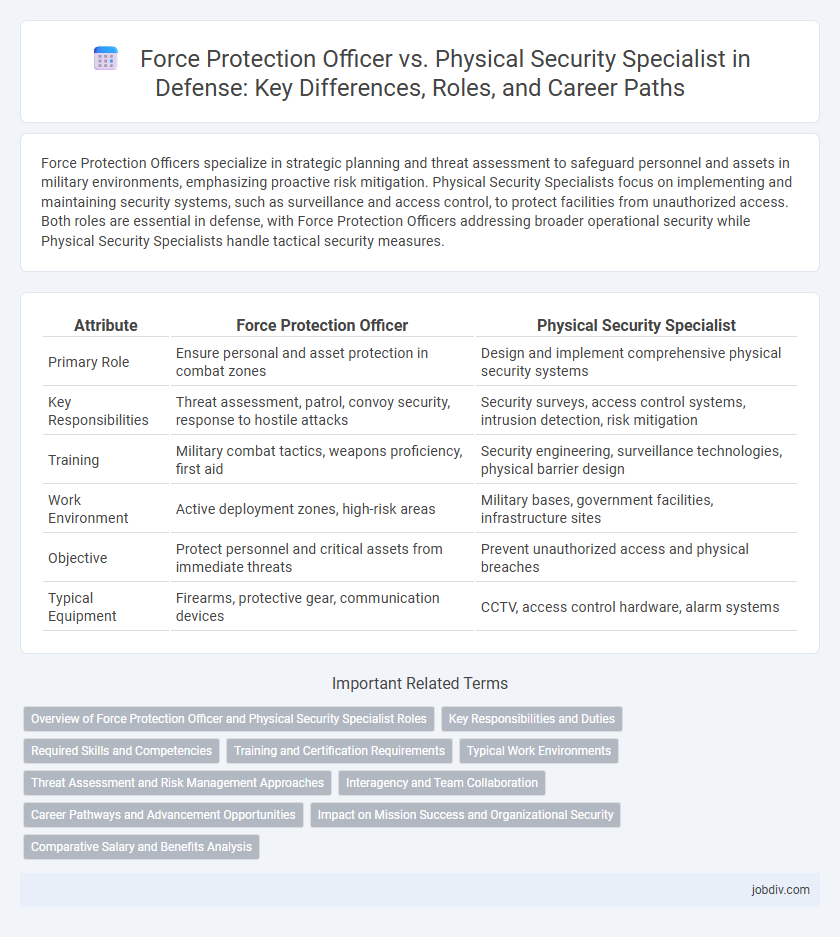Force Protection Officers specialize in strategic planning and threat assessment to safeguard personnel and assets in military environments, emphasizing proactive risk mitigation. Physical Security Specialists focus on implementing and maintaining security systems, such as surveillance and access control, to protect facilities from unauthorized access. Both roles are essential in defense, with Force Protection Officers addressing broader operational security while Physical Security Specialists handle tactical security measures.
Table of Comparison
| Attribute | Force Protection Officer | Physical Security Specialist |
|---|---|---|
| Primary Role | Ensure personal and asset protection in combat zones | Design and implement comprehensive physical security systems |
| Key Responsibilities | Threat assessment, patrol, convoy security, response to hostile attacks | Security surveys, access control systems, intrusion detection, risk mitigation |
| Training | Military combat tactics, weapons proficiency, first aid | Security engineering, surveillance technologies, physical barrier design |
| Work Environment | Active deployment zones, high-risk areas | Military bases, government facilities, infrastructure sites |
| Objective | Protect personnel and critical assets from immediate threats | Prevent unauthorized access and physical breaches |
| Typical Equipment | Firearms, protective gear, communication devices | CCTV, access control hardware, alarm systems |
Overview of Force Protection Officer and Physical Security Specialist Roles
Force Protection Officers are primarily responsible for implementing defensive measures to safeguard military installations, personnel, and resources from potential threats. Physical Security Specialists focus on assessing vulnerabilities, maintaining security systems, and ensuring compliance with security protocols to protect critical assets. Both roles are essential in defense operations, with Force Protection Officers emphasizing tactical defense and Physical Security Specialists concentrating on strategic security management.
Key Responsibilities and Duties
Force Protection Officers primarily focus on safeguarding military personnel and assets through risk assessment, threat detection, and implementation of protective measures in operational environments. Physical Security Specialists concentrate on securing infrastructure by managing access controls, surveillance systems, and security protocols to prevent unauthorized entry or damage. Both roles collaborate to enhance overall defense posture by addressing vulnerabilities and ensuring continuous safety compliance.
Required Skills and Competencies
Force Protection Officers require expertise in threat assessment, tactical planning, and emergency response coordination to safeguard personnel and critical assets. Physical Security Specialists focus on proficiency in access control systems, surveillance technology, and risk mitigation strategies for facility security. Both roles demand strong communication skills, situational awareness, and knowledge of security protocols tailored to military and defense environments.
Training and Certification Requirements
Force Protection Officers typically undergo rigorous military training emphasizing tactical operations, risk assessment, and emergency response, often complemented by certifications such as the Certified Protection Professional (CPP) and specialized weapons qualifications. Physical Security Specialists focus on technical training related to threat analysis, security systems management, and facility protection, frequently obtaining certifications like Physical Security Professional (PSP) and Security Management certification. Both roles require continuous education to stay current with evolving security protocols and technologies within defense environments.
Typical Work Environments
Force Protection Officers typically operate in high-risk military installations, forward operating bases, and deployed environments where immediate threat response and tactical defense measures are critical. Physical Security Specialists are commonly found in more structured, permanent facilities such as government buildings, corporate campuses, and critical infrastructure sites focusing on access control, surveillance systems, and policy compliance. Both roles collaborate to ensure comprehensive security but differ primarily in deployment context and operational intensity.
Threat Assessment and Risk Management Approaches
Force Protection Officers employ proactive threat assessment techniques emphasizing real-time intelligence analysis and rapid response coordination to mitigate risks in dynamic operational environments. Physical Security Specialists utilize comprehensive risk management frameworks that integrate vulnerability assessments, access control systems, and infrastructure hardening to prevent unauthorized intrusions and safeguard assets. Both roles prioritize analytic rigor but differ in execution focus, with Force Protection Officers addressing immediate threats and Physical Security Specialists concentrating on long-term security posture enhancement.
Interagency and Team Collaboration
Force Protection Officers coordinate closely with interagency partners to ensure seamless integration of intelligence and operational protocols, enhancing overall team defense capabilities. Physical Security Specialists focus on implementing technical security measures and physical barriers while collaborating with federal, state, and local agencies to address evolving threats. Both roles require robust communication and joint training exercises to foster effective interagency and multidisciplinary teamwork in defense environments.
Career Pathways and Advancement Opportunities
Force Protection Officers often advance through military ranks, gaining leadership roles that emphasize combat readiness and threat response training, which prepares them for positions in tactical operations or security management. Physical Security Specialists typically pursue career growth by acquiring certifications in risk assessment and security technology, leading to roles in facility security oversight, compliance, and security program development. Both career pathways offer advancement opportunities through specialized training, experience in security protocols, and leadership skill enhancement within defense and homeland security sectors.
Impact on Mission Success and Organizational Security
Force Protection Officers directly influence mission success by implementing strategic measures to mitigate threats, ensuring personnel safety in dynamic operational environments. Physical Security Specialists enhance organizational security through the design and maintenance of comprehensive access controls, surveillance systems, and security policies. Together, their roles create a robust defense posture that minimizes vulnerabilities and safeguards critical assets.
Comparative Salary and Benefits Analysis
Force Protection Officers generally receive higher base salaries due to their deployment in high-risk environments, with averages ranging from $55,000 to $75,000 annually, compared to Physical Security Specialists who typically earn between $45,000 and $65,000. Force Protection Officers often benefit from hazard pay, deployment bonuses, and comprehensive military-grade health and retirement packages, whereas Physical Security Specialists primarily access standard government employee benefits and performance-based incentives. Both roles provide opportunities for professional development, but Force Protection Officers enjoy enhanced compensation structures reflecting the greater operational risks and responsibilities inherent in their duties.
Force Protection Officer vs Physical Security Specialist Infographic

 jobdiv.com
jobdiv.com